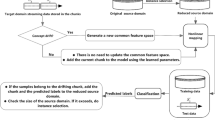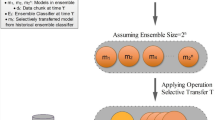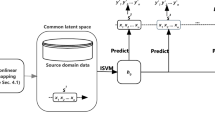Abstract
Concept drift is one of the key challenges that incremental learning needs to deal with. So far, a lot of algorithms have been proposed to cope with it, but it is still difficult to response quickly to the change of concept. In this paper, a novel method named Selective Transfer Incremental Learning (STIL) is proposed to deal with this tough issue. STIL uses a selective transfer strategy based on the well-known chunk-based ensemble algorithm. In this way, STIL can adapt to the new concept of data well through transfer learning, and prevent negative transfer and overfitting that may occur in the transfer learning effectively by an appropriate selective policy. The algorithm was evaluated on 15 synthetic datasets and three real-world datasets, the experiment results show that STIL performs better in almost all of the datasets compared with five other state-of-the-art methods.
Access this chapter
Tax calculation will be finalised at checkout
Purchases are for personal use only
Similar content being viewed by others
References
Gama, J., Žliobaitė, I., Bifet, A., Pechenizkiy, M., Bouchachia, A.: A survey on concept drift adaptation. ACM Comput. Surv. 46(4), 44 (2014)
Bifet, A., Gavalda, R.: Learning from time-changing data with adaptive windowing. In: Proceedings of the SIAM International Conference on Data Mining, pp. 443–448 (2007)
Hulten, G., Spencer, L., Domingos, P.: Mining time-changing data streams. In: KDD, pp. 97–106 (2001)
Gama, J., Medas, P., Castillo, G., Rodrigues, P.: Learning with drift detection. In: Bazzan, A.L.C., Labidi, S. (eds.) SBIA 2004. LNCS, vol. 3171, pp. 286–295. Springer, Heidelberg (2004). doi:10.1007/978-3-540-28645-5_29
Street, W.N., Kim, Y.: A streaming ensemble algorithm (SEA) for large-scale classification. In: KDD, pp. 377–382 (2001)
Brzezinski, D., Stefanowski, J.: Reacting to different types of concept drift: the accuracy updated ensemble algorithm. IEEE Trans. Neural Netw. 25(1), 81–94 (2014)
Elwell, R., Polikar, R.: Incremental learning of concept drift in nonstationary environments. IEEE Trans. Neural Netw. 22(10), 1517–1531 (2011)
Sun, Y., Tang, K.: Incremental learning with concept drift: a knowledge transfer perspective. In: Gong, M., Pan, L., Song, T., Zhang, G. (eds.) BIC-TA 2016. CCIS, vol. 681, pp. 473–479. Springer, Singapore (2016). doi:10.1007/978-981-10-3611-8_43
Pan, S.J., Yang, Q.: A survey on transfer learning. IEEE Trans. Knowl. Data Eng. 22(10), 1345–1359 (2010)
Yule, G.U.: On the association of attributes in statistics: with illustrations from the material of the childhood society, &c. Phil. Trans. 194, 257–319 (1900)
Kuncheva, L.I., Whitaker, C.J., Shipp, C.A., Duin, R.P.: Is independence good for combining classifiers? Pattern Recognit. 2, 168–171 (2000)
Forman, G.: Tackling concept drift by temporal inductive transfer. In: SIGIR, pp. 252–259 (2006)
Minku, L., Yao, X.: DDD: a new ensemble approach for dealing with concept drift. IEEE Trans. Knowl. Data Eng. 24(4), 619–633 (2012)
Domingos, P., Hulten, G.: Mining high-speed data streams. In: KDD, pp. 71–80 (2000)
Bache, K., Lichman, M.: UCI Machine Learning Repository. http://archive.ics.uci.edu/ml (2013)
Schlimmer, J.C., Granger, R.H.: Incremental learning from noisy data. Mach. Learn. 1(3), 317–354 (1986)
Acknowledgments
This work was supported in part by the National Natural Science Foundation of China under Grant 61329302 and Grant 61672478, and in part by the Royal Society Newton Advanced Fellowship under Grant NA150123.
Author information
Authors and Affiliations
Corresponding author
Editor information
Editors and Affiliations
Rights and permissions
Copyright information
© 2017 Springer International Publishing AG
About this paper
Cite this paper
Xie, G., Sun, Y., Lin, M., Tang, K. (2017). A Selective Transfer Learning Method for Concept Drift Adaptation. In: Cong, F., Leung, A., Wei, Q. (eds) Advances in Neural Networks - ISNN 2017. ISNN 2017. Lecture Notes in Computer Science(), vol 10262. Springer, Cham. https://doi.org/10.1007/978-3-319-59081-3_42
Download citation
DOI: https://doi.org/10.1007/978-3-319-59081-3_42
Published:
Publisher Name: Springer, Cham
Print ISBN: 978-3-319-59080-6
Online ISBN: 978-3-319-59081-3
eBook Packages: Computer ScienceComputer Science (R0)




